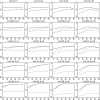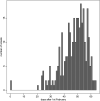Estimating a time-to-event distribution from right-truncated data in an epidemic: A review of methods
- PMID: 34931911
- PMCID: PMC9465556
- DOI: 10.1177/09622802211023955
Estimating a time-to-event distribution from right-truncated data in an epidemic: A review of methods
Abstract
Time-to-event data are right-truncated if only individuals who have experienced the event by a certain time can be included in the sample. For example, we may be interested in estimating the distribution of time from onset of disease symptoms to death and only have data on individuals who have died. This may be the case, for example, at the beginning of an epidemic. Right truncation causes the distribution of times to event in the sample to be biased towards shorter times compared to the population distribution, and appropriate statistical methods should be used to account for this bias. This article is a review of such methods, particularly in the context of an infectious disease epidemic, like COVID-19. We consider methods for estimating the marginal time-to-event distribution, and compare their efficiencies. (Non-)identifiability of the distribution is an important issue with right-truncated data, particularly at the beginning of an epidemic, and this is discussed in detail. We also review methods for estimating the effects of covariates on the time to event. An illustration of the application of many of these methods is provided, using data on individuals who had died with coronavirus disease by 5 April 2020.
Keywords: Coronavirus disease; Cox regression; failure time; identifiability; relative efficiency; right-truncation; survival analysis.
Conflict of interest statement
Figures





References
-
- Brookmeyer R, Damiano A. Statistical methods for short-term projections of AIDS incidence. Stat Med 1989; 8: 23–34. - PubMed
-
- Kalbfleisch JD, Lawless JF. Inference based on retrospective ascertainment: An analysis of the data on transfusion-related AIDS. J Am Stat Assoc 1989; 84: 360–372.
-
- Lynden-Bell D. A method of allowing for known observational selection in small samples applied to 3CR quasars. Mon Not R Astron Soc 1971; 155: 95–118.
-
- Turnbull BW. The empirical distribution function with arbitrarily grouped, censored and truncated data. J R Stat Soc, Ser B 1976; 38: 290–295.
Publication types
MeSH terms
Grants and funding
LinkOut - more resources
Full Text Sources
Medical
Miscellaneous

